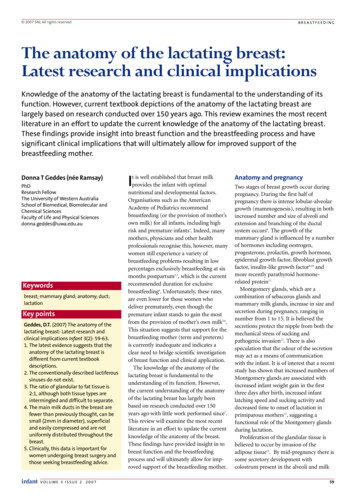Classroom Environment For Children . - RTI International
Classroom Environment for Children withDisabilities in Kenyan PreschoolsEileen DombrowskiDr. Yasmin Sitabkhan, Tabitha KilonzoRTI InternationalRTI International is a registered trademark and a trade name of Research Triangle Institute.www.rti.org
Inclusive Education in Low- and Middle-Income CountriesBackground Only 2% of children with disabilities attend school (UNESCO 2004)– Significantly less likely to be enrolled in school than children without disabilities(Filmer, 2008). In many countries, only children with physical disabilities included (Wapling 2016)Integration v. Inclusion Integration: children with disabilities adapt to the current classroom Inclusion: the classroom changes to better adapt to the needs of children withdisabilities2
Inclusive Education in KenyaPolicies Inclusive education:– Mandated in Kenya in 2003– A special needs education policy in 2009 aimed to give learnerswith disabilities equal access to quality educationImpact Only 67% of children with disabilities accessing mainstreamprimary schools (UN OCHR 2011) Special education enrollment represents 30% of the expectednumber of learners with disabilities (Kett, Deluca, and Carew2018).3
Purpose of the StudyTo examine the interactions betweenpre-primary teachers and the childrenwith disabilities in their classroomsResearch questions1. What types of interactions occur betweenthese students and their teachers?2. What types of interactions occur betweenthese students and their peers?3. How were teacher attitudes towards childrenwith disabilities reflective of their interactionswith these children?4
MethodsSample selection Coaches identified classrooms that may have children with disabilities– 33 pre-primary 2 classrooms identified– 5 classrooms chosen based on coach descriptionsClassroom Observations Two researchers took data on:– How teachers organized classrooms– What types of interactions occurred (teacher and peer)– If the teacher was adapting instruction for children with disabilitiesTeacher Interview Interviewed teachers about their instruction, attitudes and what resources theyneeded to teach children with disabilities5
Methods (cont.)Interaction Type Type of interaction coded as:– Instructional support: Teachers provide modifications or individualization toinstruction– General classroom routine: Teachers performing everyday tasks– Behavior management: Teachers prevent and redirect misbehaviorEmotional Tone Emotional tone of each interaction coded as:– Positive emotional tone: teacher displayed warmth and enthusiasm– Negative emotional tone: teacher expressed anger or hostility– Neutral emotional tone: neither positive nor negative6
Results: Type of Interaction 100 interactions observed between teachers and students withdisabilities The majority of interactions were for instructional support– Shows teachers prioritized learning needs of children withdisabilities– When teachers asked how they supported children withdisabilities, all five shared examples of instructional support 1/3 of interactions were for behavior management– Contradicts assumption that interactions would focus onbehavior management (Obeng 2012) The rest were general classroom routine7
Results: Emotional ToneEmotional Tone of Classroom ior Mgmt8Gen. ClassroomRoutineNeutral ToneInstruct. SupportNegative TonePositive ToneTotal
Results: Peer Interactions & Teacher InterviewsPeer Interactions 17 interactions with peers were observed; only 1 was negative Peers accepted children with disabilities as members of class and attempted tosupport them within classroom activities– Ex: peer in Classroom 3 attempted to help child with disabilities find the correctpage in her workbook9Teacher Interviews All five teachers observed attempting to differentiate instruction Teachers said:– They arranged classroom to better serve child with disabilities– Teaching children with disabilities had some challenges– They would benefit from additional training to help them better support childrenwith disabilities
ConclusionSummary The inclusion we observed:– was meaningful (more inclusion thanintegration)– was primarily focused on instructionalsupport Teachers were motivated to differentiateinstructionNext Steps More research with larger samples More training to help teachers differentiatemore effectively Research into effectiveness of teacher training10
Thank You!Contact me with any questions:Eileen Dombrowski: edombrowski@rti.org11
RTI International is a registered trademark and a trade name of Research Triangle Institute. www.rti.org Classroom Environment for Children with . 1/3 of interactions were for behavior
Bruksanvisning för bilstereo . Bruksanvisning for bilstereo . Instrukcja obsługi samochodowego odtwarzacza stereo . Operating Instructions for Car Stereo . 610-104 . SV . Bruksanvisning i original
This manual is intended to provide guidance for implementation of RtI, but RtI is a process that will continue to evolve. Oconto Falls RtI Belief Statements and Guiding Principles All Children can learn and all Children can make progress. Our RtI framework starts with a strong core instruction that is differentiated to student needs.
classroom classroom 30 31 classroom 32 classroom 33 classroom 35 classroom 36 classroom 37 classroom 38 classroom 39 classroom 40 classroom 41 classroom 42 classroom 43
overview of DDS terms, please see the RTI Data Distribution Service User’s Manual. Chapter 1 1-2. 2-1 2. Configuring RTI Recorder . This configuration file provides a configur ation that can be used with the tutorial found in the RTI Recorder Getting Started Guide to learn about how to modify RTI
10 tips och tricks för att lyckas med ert sap-projekt 20 SAPSANYTT 2/2015 De flesta projektledare känner säkert till Cobb’s paradox. Martin Cobb verkade som CIO för sekretariatet för Treasury Board of Canada 1995 då han ställde frågan
service i Norge och Finland drivs inom ramen för ett enskilt företag (NRK. 1 och Yleisradio), fin ns det i Sverige tre: Ett för tv (Sveriges Television , SVT ), ett för radio (Sveriges Radio , SR ) och ett för utbildnings program (Sveriges Utbildningsradio, UR, vilket till följd av sin begränsade storlek inte återfinns bland de 25 största
Hotell För hotell anges de tre klasserna A/B, C och D. Det betyder att den "normala" standarden C är acceptabel men att motiven för en högre standard är starka. Ljudklass C motsvarar de tidigare normkraven för hotell, ljudklass A/B motsvarar kraven för moderna hotell med hög standard och ljudklass D kan användas vid
The anatomy of the lactating breast: Latest research and clinical implications Knowledge of the anatomy of the lactating breast is fundamental to the understanding of its function. However, current textbook depictions of the anatomy of the lactating breast are largely based on research conducted over 150 years ago. This review examines the most .























